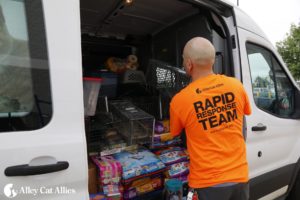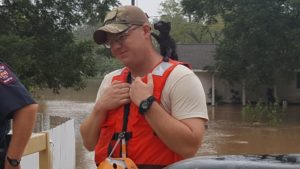It was one year ago on August 25 that Hurricane Harvey swept through the Texas coast, causing $125 billion in damage and displacing thousands of people and animals.

Alley Cat Allies’ expert, bilingual disaster response team provides care and supplies following Hurricane Harvey.
Alley Cat Allies sprang to action, sending an expert, bilingual disaster response team to ensure community cats and other animals were rescued and cared for. We provided critical supplies and emergency funds to the five animal protection organizations highlighted below, as well as the Humane Society of Louisiana.
Today, Alley Cat Allies continues to work with organizations in their efforts to help animals affected by Harvey, as their communities rebuild.
Austin Pets Alive! Strengthens Its Mission
Austin Pets Alive! took in animals from coastal areas and ran a temporary shelter in Houston for more than four months after Harvey. It took in 783 animals in August 2017 alone (compared with 322 the previous August), and since then, its monthly average animal intake has increased, compared to previous years.
The shelter has continued partnerships with coastal organizations and built up staff, including expanding its medical team to help more cats, says Mary Heerwald, the group’s director of marketing and communications.
A Life to Live Builds Trap-Neuter-Return
Since Hurricane Harvey, Alley Cat Allies has been working with A Life to Live, a member of our Feral Friends Network, in coastal Baytown, Texas, which was hit hard with flooding. We helped carry out Trap-Neuter-Return (TNR) following Harvey and are now working with the group to strengthen a TNR program in the city.
“There are some houses that are still under renovation and construction, and there are some families who are still displaced,” says A Life to Live Founder and President Jay Garrett. “Unfortunately, there are a ton of vacant houses and vacant buildings.”
To be prepared in the event of future disasters, A Life to Live is seeking funding for an evacuation trailer for its animals in foster careusually about 75.
“If a natural disaster comes again, those 75 animals in foster homes need somewhere to go,” says Garrett. “In not all cases do the fosters have the ability to take the animals in their care with them. We need to take responsibility for the animals in our program and provide the safety net for them.”
Wharton County SPOT Helps Animals Affected by Slow Recovery
Requests for help to Wharton County Stray Pet Outreach Team (SPOT) have increased in the year since Harvey, as families struggle to recover, says Christine Stransky, president of the animal rescue group. She says people were still cleaning up flood debris in July, 11 months after the hurricane tore through the region.

Wharton County SPOT helps rescue kitten Darpa, who was transferred to Austin Pets Alive! and has since been adopted.
The largely rural county doesn’t have an animal shelter, so Wharton County SPOT fills that role to help about 350 animals each year.
“We still have people who have gone somewhere else to live,” says Stransky. “If they are back, they’re living in a trailer on their property. They can’t keep their pet.”
Stransky says she’s thankful for the people who have come to her organization’s aid to help cats. She recalled that her neighbor fostered Belle, a cat who was rescued from floods by the National Guard when Stransky’s own home was already full of rescued animals. Time passed, and no owners reclaimed Belle. (The organization has had difficulty reuniting pets and owners, a common problem after disasters.) However, Belle got a happy ending when Stransky’s neighbor adopted her.
Stransky hopes people don’t forget about the needs of organizations that are still working to recover from Harvey.
“On the year anniversary, if they can think about an organization or a group they supported a year ago,” she says, “they could reach out again and see what they can do to help.”
CATNIP Foundation Stresses Importance of Spay and Neuter
The Louisiana-based CATNIP Foundation still gets updates from the family it reunited with their cat Rudy following Hurricane Harvey. CEO Catherine Wilbert found Rudy in a flooded house, taking refuge on top of a floating mattress, during one of her rescue trips to Texas.
Another rescued cat, black and white Bones, has become the organization’s “spokescat,” Wilbert says. She brings him to news interviews and events to help educate people about disaster preparedness.
The CATNIP Foundation, a member of the Alley Cat Allies Feral Friends Network, took in more than 200 cats following Harvey and Irma. It also continued with its regular intake and TNR efforts. Many cats Wilbert rescued from Harvey have been adopted, but there are some who are unadoptable and will live out their lives at the sanctuary.
Although the disasters put a stress on her organization’s resources, it continues to be proactive about spaying and neutering, and educating the community about its importance. Following the hurricanes, the organization used much of its medical budget to spay and neuter rescued cats.
“If we don’t spay and neuter, it makes all these disasters way worse,” she says.
Friends for Life Shares How to Shelter Animals and People in Emergencies
Houston-based Friends for Life proved during Hurricane Harvey that animals and people could safely cohabitate in emergency shelterssaving lives and keeping families togetherand is now sharing its expertise in a recently published manual.
“We didn’t know what to expect,” says Salise Shuttlesworth, Friends for Life founder and executive director, of her organization’s commitment to run animal care at the George R. Brown Convention Center, a “mega-shelter” for evacuees. “We felt as if we were changing the wheels on a car going 100 miles per hour.”
To help other organizations in similar situations, the group worked with the United States Department of Agriculture, the Louisiana Department of Agriculture and Forestry, and the American National Red Cross to create the manual that guides organizations on how to run an emergency shelter with animals. It includes information about the resources needed, communication strategies, and chains of command.
“We succeeded in using this model and now we put this model into print in a way that is shareable with any organization that wants it,” says Shuttlesworth.
As for Houston recovery, Shuttlesworth says, “We’re seeing increases in community cat populations because the people who were feeding and doing TNR are sometimes no longer in the neighborhoods.”
Friends for Life is increasing its TNR efforts and has already made great strides with its Fix Houston targeted TNR program, with help from Alley Cat Allies’ resources. Through the program, more than 4,600 cats have been spayed or neutered free of charge.
Houston, having learned from this experience, is “in better shape as a community” to deal with future disasters, Shuttlesworth says.

